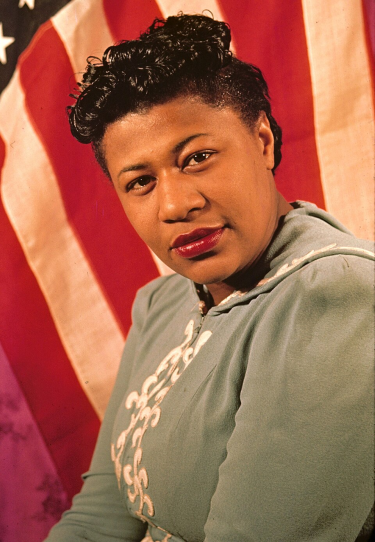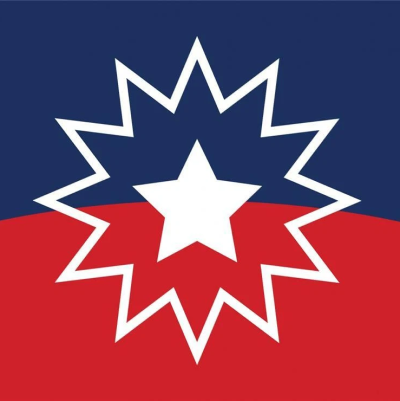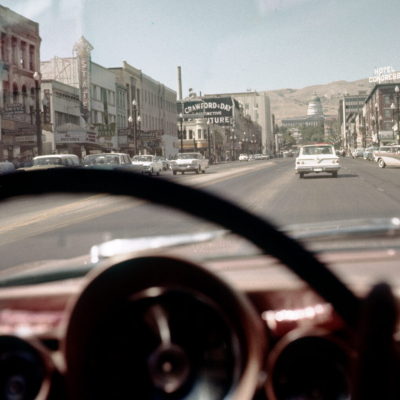.
.
photo by Shannon Brazil
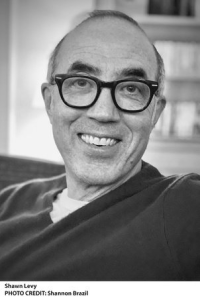 Shawn Levy, author of In On the Joke: The Original Queens of Stand-up Comedy [Doubleday/a division of Random House]
Shawn Levy, author of In On the Joke: The Original Queens of Stand-up Comedy [Doubleday/a division of Random House]
.
.
___
.
.
…..In today’s world of stand-up comedy, women are distinguished performers whose acts fill auditoriums and provoke their stardom in blockbuster movies. But before the likes of Amy Schumer, Tiffany Haddish, and Ali Wong, it took courageous and revolutionary women of mid-20th century America who were willing to confront extreme cultural barriers and participate in a corner of the entertainment world previously inhabited by men only. Among them:
-Moms Mabley, described by Shawn Levy, author of In On the Joke: The Original Queens of Stand-up Comedy, as being the epitome of a woman struggling to be accepted as a stand-up comedian – a Black woman who “began her career not long after World War I, performing in an all-Black vaudeville circuit (sometimes even in blackface), and she ended it in the 1970s, as a staple on TV.”
-Jean Carroll, who began doing stand-up, alone in front of a microphone, in the mid-1940s, when, Levy points out, “there wasn’t even a name for what she did,” and who was ultimately recognized as the “female analogue of such notable jokesters as Milton Berle, Bob Hope, and Henny Youngman.”
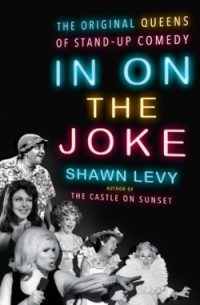
-Minnie Pearl, “the cheerful, ditzy, man-crazy country girl who regaled audiences with tales of her family, her adventures in chasing down ‘fellers,’ her encounters with the occasional city slicker, and daily life in her tiny rural hometown of Grinder’s Switch, Tennessee.”
-A handful of bawdy comedians like Belle Barth and Rusty Warren who “felt empowered to stand before a microphone and tell jokes, a clutch of them in scatological humor coated with a veneer of song.”
-Phyllis Diller, the first woman superstar of stand-up comedy who joked about “her deficiencies as a sex object and homemaker; her husband’s sloth and stupidity; the ghastliness of her in-laws; and the foibles of modern life…that made her both an ordinary woman and a comedian of the moment.”
-Elaine May, “indisputably a major instigator of a revolution in comedy the impact of which is still being felt today. She brought [improvisational comedy] to the highest level of perfection and acclaim,” and who “wasn’t only the first woman to become a star in the branch of modern comedy known as improv, she helped create the ‘rules.”
-Joan Rivers, “something like the Beatles of her chosen field,” who “bore at least some portion of the gifts of almost every woman who preceded her in the business; the wit, the determination, the thick skin, the hunger, the pugnacity, the ambition, the courage.”
…..Levy’s book consists of concise biographies of these women (and others). It is great fun and a captivating, intelligent history in which he reminds readers of the brilliant women comedians who appeared in clubs and in mid-20th century homes via the new medium of television, and an eye-opening reminder of the challenges they faced breaking into the boys club of stand-up comedy, offering new ideas of womanhood along the way.
…..Levy discusses these women and his book in a May 26, 2022 interview with Jerry Jazz Musician editor/publisher Joe Maita.
.
.
___
.
.
“Phyllis Diller was one of a handful of women in comedy who had broken ground, blazed trails, knocked down doors, and made careers and legends for themselves regardless of the opinions of men. As in so many aspects of her career – indeed, in having a career as a comedian at all – she simply would not be denied.
“That pretty much sums up the history of women in stand-up comedy, particularly the early history, when the women in these pages rose as more or less the first women to think that they could (duh) be as funny and sharp and entertaining as male joke tellers and who chose to pursue careers at it. They worked alone for the most part, both in the sense that they were almost all solo performers and in the sense that, in many cases, they didn’t know about one another or see one another as doing the same thing as themselves. They faced the indifference, puzzlement, nay-saying, and sometimes enmity of agents, managers, impresarios, audiences, critics, fellow performers, even their families. And yet they persisted, persevered, pushed forward, making their way ever farther and higher, if only incrementally, and clearing space not only for themselves but for the women working alongside them and for the women who followed them in the curious business of making people laugh for a living.”
-Shawn Levy, from the introduction to his book In On the Joke: The Original Queens of Stand-up Comedy [Doubleday/a division of Random House]
.
Watch Phyllis Diller perform on a 1968 episode of Hollywood Palace
.
JJM Your book In on the Joke is an assemblage of concise, informative biographies of women in standup comedy between World War II and 1970. Moms Mabley, Jean Carroll, Belle Barth, Pearl Williams, Rusty Warren, Phyllis Diller, Elaine May, Totie Fields and Joan Rivers are among those you profiled. Why did you decide to write this book?
SL There were two reasons, really. One is that my partner Shannon and my daughter Paula have been asking me for years when I was going to write a book about a woman. I’ve written a lot of books about creepy men – Frank Sinatra, Jerry Lewis, Robert De Niro, Porfirio Rubirosa, and Mick Jagger – so it was a good question. I thought about some women I wanted to write about, particularly Sophia Loren, who appears in one of my books prominently, and who I think could support a whole biography. I’ve also considered writing about Catherine Deneuve and Bridgette Bardot, but I’ve never been able to sell it to either my agent or a publisher.
This book came about through an idea I had about doing a book about politics and comedy, and how America evolved from a culture where comedians never talked about politics, to a culture where some comedians only talked about politics and “ripped-from-the-headlines” humor. It was during that process – in the late 1950’s and early 1960’s – when women entered the comedy space, so I proposed doing a chapter on women becoming more common in the stand-up comedy world. My editors and agent focused on that, and they wondered if there may be an entire book on that topic. This book blossomed from there. I didn’t know much of anything about the women or the subject, but I knew what shape the book would take, and I knew it would end with Joan Rivers. Most accounts of women in comedy sort of begin with Joan, but I wanted to write about the road to her becoming a superstar.
JJM What is your own experience with witnessing these comedians?
SL I was born in New York City in 1961, and my parents were infatuated with showbiz. Big events in our house would be watching television shows like the annual Jerry Lewis Labor Day telethon, and when the Sunday New York Times came they would devour the ads to see who’d be performing at the Westbury Theatre or some other place near where we lived on Long Island that showcased the sort of entertainers featured in this book – Totie Fields, Joan Rivers, Phyllis Diller, or various singers they were interested in. So for me, many of these people I write about were like constellations, but not all of them – I didn’t know anything about Jean Carroll, for instance, but as I discovered she is a huge figure in comedy who has been totally forgotten. I’ve rarely encountered anyone during the process of publicizing this book familiar with her work. I also didn’t have any particular concept of Minnie Pearl; I thought she was just this corny, foolish character from a culture that I didn’t value much as a young man. And while I have come to enjoy several traditional country and western performers over the years, I still have no specific memories of the Grand Ole Opry while growing up. As I researched her to determine if she fits in this book, I discovered a remarkable woman whose story I’m just delighted to share. So, I knew about half of the women I profile and the other half I learned as I was writing, and I can honestly say there’s something I learned on every page in this book.
JJM I had the same experience with Jean Carroll, to tell you the truth. I found a terrific clip of her appearing on Ed Sullivan, but I don’t remember her. Other than the “bawdy” performers like Belle Barth, I am familiar with all of the other women you profile – most of whom were household names when I was growing up.
SL My folks had the big hit Belle Barth album, If I Embarrass You Tell Your Friends, but I never even thought to play it because she just looked like someone’s old Jewish grandma. I didn’t figure there would be anything on the record that I’d enjoy. But when I listened to it while writing the book, I couldn’t help but think how different my life would have been if I first heard it when I was 10 or 11 years old!
JJM All of these women were so gifted and unique, but what were some of their common challenges?
SL All of them had a desire to be a performer, so they shared the urge to be in the spotlight, and they all tried everything to succeed. Many of them began as singers because they performed at a time when it was unheard of for women to be stand-up comedians – if a woman came to a microphone on her own, you expected her to sing, or maybe even undress. One of the titles we considered for the book was “Why Isn’t She Singing?”, which would have been the reaction of the audience.
Denny-Moeller Talent, Inc., Public domain, via Wikimedia Commons
Minnie Pearl
.
ABC Television, Public domain, via Wikimedia Commons
Phyllis Diller, 1966
All of them were the class clown, or the wittiest or most energetic of their group while growing up, and many began in vaudeville or in troupes doing sketch comedy, and they were always the standout when you look at the early reviews. As an example, Joan Rivers was in a comedy troupe trio, Jim, Jake and Joan, and in the very few reviews they ever received that I was able to dig up, she was considered the standout. So they all have that, but they also all had an incredible self-belief, because it’s very likely that – particularly the earliest three or four of them – they had no idea about one another. Moms Mabley was working very strictly in Black showbiz performing on the “Chitlin Circuit” that was part of the Theatre Owners Booking Association, “TOBA” – which became known as “Tough On Black Asses.” Minnie Pearl was working in the country music arena. Jean Carroll worked in the Borscht Belt nightclubs of the Catskills. There was no Friars Club, and they didn’t share an agent who specialized in women comedians, so they were really alone at the mic, and probably felt alone in the world. It’s tough enough to be a stand-up comedian because it’s a brutal job – you have to be funny every 20 seconds, you have no one to share the stage with, and you live and die on the strength of your ability to read the crowd and adapt to their energy. And afterwards there was no one they could get together with to talk shop. The men, meanwhile, had a completely different experience. So that tenacity and rigor of mind is consistent throughout all of these women, who were inventing an art form as they went along.
JJM You opened the book with the anecdote about Phyllis Diller dressing as a man just so she could get into the Friars Club events. So not only did they lack their own type of Friars Club, they were not welcome in it.
SL Right. And that happened in the mid-1980’s, when Phyllis Diller was well-established and living in a mansion in Bel Air. You couldn’t have a bigger career in comedy than she had, yet in order to sit and watch Buddy Hackett tell a few jokes at the Friars Club, she had to dress in drag.
JJM Who were some of the comedians or vaudeville performers that had an influence on the women you write about?
University of Washington, Public domain, via Wikimedia Commons
SL There were many women who performed comic sketches or worked in comedy teams in vaudeville – Black and white – who would have carried some kind of influence. Fanny Brice, Sophie Tucker, and Gracie Allen, for example, didn’t stand-up at a microphone and tell jokes in the vein of Bob Hope or Milton Berle, but they were the funny one. Oftentimes, the man was the straight man and the woman – known in vaudeville as the “Dumb Dora” – was the one who would say the funny line. The most famous “Dumb Dora” in showbiz was either Gracie Allen or Lucille Ball, depending on your generation. The women I write about were often in that role, but they were also the clever one, the one who came up with the scripts, and it became clear to them that they were doing the heavy lifting and carrying their man around. Jean Carroll’s husband Buddy Howe was her comedy partner, and there is a quote in the book where he says if she ad-libbed he felt lost because she did all the writing, and he had to wait for her to get back on script so he could say his next line. So, there were funny women, there just weren’t any stand-up comedians. For the purpose of the book I tried as much as possible to narrow the field to that. In showbiz they call it “working in one,” where you’re the only person on stage, living and dying on your own wits.
JJM Comedy was dominated by “men of privilege” who either wrote their own jokes or had a team of male comedy writers, which required money to access their talents. And none of these women had access to that…
SL Minnie Pearl – her real married name was Sarah Cannon – could write for her character and she also had writers on the Grand Ole Opry to help her out. She was on the radio for 50 years, and her broadcasts were four hours long. She would do her ten minutes as “Minnie,” but she’d also frequently be the emcee of the show, where she had to do some back-and-forth bantering with some of the musicians. It was very common in the world of country music for musicians to have a comic personality, so someone like Roy Clark, who was on the television show Hee Haw, was capable of comedy banter, but he was really just a fine musician who happened to have a sense of humor and a charming personality, and Minnie would often be paired opposite someone like him for a couple of bits during a broadcast. Phyllis Diller worked with writers and actually offered five bucks to anyone who sent her a joke that she used, and she would get bags full of mail. The most prolific writer of her career was a housewife from the Midwest who sent her volumes of material. When Phyllis died, her family donated her joke archive to the Smithsonian, which included more than 70,000 jokes. She was clever, but she wasn’t that clever.
.
A video interlude…Watch a 1967 performance of Moms Mabley on The Smothers Brothers Show
.
JJM Of all the women you profiled, only Moms Mabley is Black. Her challenges must have been particularly daunting.
SL I had to trim the book a bit here and there, so two of the Black women profiled in the chapter on Moms Mabley – Hattie Noel and LaWanda Page – originally had longer chapters unto themselves, but Moms Mabley was who they followed in the wake of so it made sense to put them under her umbrella. Moms was born into a very large family in Brevard, North Carolina in 1894. She left home as a teenager, after she had been raped at least twice and delivered children after those crimes. She briefly caught up with some vaudeville people and performed with them. She got pregnant again and returned home, but after that third baby was born she left home for good.
She began on that “TOBA” circuit, which traveled constantly and during which time she would go town-to-town and perform up to 15 shows a week. Her contract required her to do a complete circuit, and if she messed up she would have to do the circuit all over again. She was making something like 15 bucks a week and room-and-board, and the work was basically a form of indenture, she worked so hard. She was rescued from this by a comedy duo, Butterbeans and Susie, who sang bawdy songs and performed comedy, and who thought Moms was quite talented. When they left the TOBA circuit they encouraged Moms to join them, and they brought her to New York, where she fell into clover.
Associated Booking Corporation/Photo by James Kriegsmann, NY, Public domain, via Wikimedia Commons
She arrived in New York in the late 1920’s during the height of the Harlem Renaissance and she fit right in – she loved the highlife, she loved to gamble, and she loved to dress up. She was queer, which was difficult to reconcile with the sort of rural and church upbringing she had in the South, but in New York City she could walk the streets of Harlem in men’s clothes and have showgirls on her arm. And while she might be catcalled and heckled by people, there were plenty of people who thought nothing of it. So she was very fortunate to land in that place.
She ultimately became a headliner for almost 50 years, and wherever she went she was the first and the biggest and the most of any woman who ever did those things. She wasn’t recorded on LP’s until she’d been in showbiz for about 35 or 40 years, she didn’t appear on television for another ten years beyond that, and her star was rising until her death in 1975, when she was 81 years old. Her story is a great story, and what I write about her in this book is the most anyone has ever written about her, with the most information and the most detail, and I believe she deserves an entire biography written about her. She’s just a terrific figure, and her life story is the story of a century.
JJM And she spoke openly about race relations, and almost always couched in humor…
SL Yes. She was kind of like Will Rogers, who was one of the first and only comedians of his era to talk about political events, but he would do so in a gentle way. Moms would talk about racism, but she wasn’t a fire eater, she was a comedian. She began taking on the persona of an old granny when she was in her thirties, and while in character would think of her grandmother, who lived in slavery and would sit around the fire telling stories and offering bits of common sense. That was the seed of the Moms Mabley character, which she did for most of her career. She’d joke about getting a call from the president, or a running joke she told was of her being pulled over by a cop in the South for going through a red light, and she said, “Well, I saw the white people going through the green light, so I thought the red light was for us.” It was a funny joke on herself, but it’s also a joke about segregation that was being told to Black audiences – and they didn’t need anyone to decode it for them, they understood what she was saying. And then when she recorded on LP for the Chess record label in the late 1950’s, she became popular with young college audiences and white kids who were hip to what she was talking about. They were questioning the truths they had grown up on, and here was this old woman telling them what was true and what wasn’t, which was the start of her true superstardom.
JJM An entertaining chapter of your book deals with all the bawdy women comedians, Belle Barth and Rusty Warren among them. They were controversial, even arrested for obscenity just as Sophie Tucker had been during a show in Portland, Oregon (where we both live), in 1910…
SL There are two things in every book I’ve written; one is Dean Martin, and the other is Oregon. I couldn’t find an Oregon angle for this book until, while researching the bawdy women comedians, I discovered that Sophie Tucker had been arrested for obscenity in Portland at the Pantages Theater. Big theaters were so important during the era of live entertainment, prior to talking movies, and the Pantages was a big vaudeville stop. One of my favorite Portland anecdotes is that Charlie Chaplin signed his first movie contract at the old Portland Hotel, which is now Pioneer Courthouse Square. People from the Essanay movie company were tracking him down and chasing him around while he was on a vaudeville tour, and they finally found him in his hotel in Portland and got him to sign a contract. Chaplin urged them to sign his roommate on that vaudeville tour as well but they passed, and that guy turned out to be Stanley Jefferson, who became famous as Stan Laurel. The idea that there was a vaudeville show in Portland with Charlie Chaplin and Stan Laurel and that they were roommates at the Portland Hotel just blows my mind.
.
An audio interlude…Listen to Belle Barth from her 1960 album, If I Embarrass You, Tell Your Friends
.
JJM What connected the bawdy women stand-up comedians to their audiences?
SL This was basically a small group of women musicians and singers who played just “okay.” Their talents were of interlude piano bar quality who were never going to headline or play in theaters – they might play a little in between the acts and maybe even do a little emceeing. They began by doing some suggestive parodies of popular songs and mix in a dirty joke, which became a popular thing. This started on party records in the 1930’s and 40’s, and they’d eventually perform at nightspots in resort towns – not at the resort itself but at the roadhouse down the road. So, after you put the kids to bed in the hotel, you might go down the road for a late-night drink, and that’s where these people performed. They played in places like the Catskills, in the beach towns of southern Florida, or in the outskirts of Las Vegas, but they wouldn’t perform in town because the material was considered so suggestive and outright obscene that they were always subject to arrest.
Belle Barth was the most notorious of these comedians, and her stuff was “dirty” but not shocking, but she was being arrested regularly in the 1950’s. This was at a time when Lenny Bruce was still trying to work as a straight comedian and not really pushing the edge of things, but Belle Barth, who looked like Bruce’s elderly aunt, was being arrested again and again. When she did perform in big cities after she was a recording star, she would frequently be surrounded by policemen and representatives of the district attorney’s office or some other moral authority of a town because they were waiting to arrest her for her blue language or suggestive song lyrics. It’s an amazing story. And Belle had followers. Pearl Williams, for instance, was one of them, who was filthy compared to Belle. I found a review of Pearl Williams performing in Las Vegas, and Variety said that the stage musicians in the Las Vegas nightclub were actually wincing at her jokes. If you can make Vegas jazz musicians wince with dirty humor, you’re really doing it!
JJM Belle Barth’s record album sales were impressive. Even though record stores put records like hers and Rusty Warren’s behind the counter, they were selling hundreds of thousands of records without the benefit of radio play, rivaling sales of artists like Frank Sinatra, Ray Charles, and even Elvis Presley. So, this was clearly an interesting business model for a comic at the time.
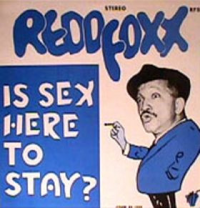
Redd Foxx/Is Sex Here to Stay? (MF Records/1978)
.
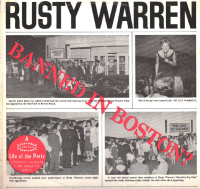
Rusty Warren/Banned in Boston (Jubilee Records/1963)
.
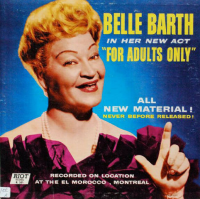
Belle Barth/For Adults Only (Riot Records/c. 1961)
SL Yes, the record album boom changed comedy. There were albums by some of the more traditional comedians, of course, but the combination of the emergence of a more personal and less genteel style of comedy in the mid-1950’s and the rise of the LP led to a phenomenon of party records. People like Redd Foxx, Belle Barth, Rusty Warren and B.S. Pulley told dirty jokes on LP’s and were being listened to by many more people than could ever fill the tiny nightclubs where they performed. As a result, they became popular stars even though their routines would never make it on the radio or television. Rusty Warren recorded for Crescendo Records, which was a legitimate record company, and became well-off financially, but Belle Barth recorded for After Hours, a fly-by-night label that not only didn’t pay her fair royalties, it went into bankruptcy when she got sued by ASCAP and BMI for doing unauthorized parodies of popular songs. So the recording business was one where you had to have someone looking out for you because there were so many shady operators who would sell millions of records without keeping appropriate books. There was no way of knowing whether proper payment was being made.
JJM Your book is a great reminder about the popularity of comedy record albums. When I was a kid, my folks had a few albums by the likes of Basie and Sinatra and 101 Strings laying around the house, and I also vividly remember their comedy records by Bob Newhart and Vaughn Meader…
SL Comedians didn’t have their own TV series built around them very often. Very few, like the stand-up comic George Burns, had their own sitcom series, so performing live on variety shows and comedy records were how these comedians made money. It wasn’t until the mid-1960’s that people started putting stand-up comedians into films and television as comedians. No one would ever think of giving someone like Lenny Bruce a movie or television role. Bill Cosby was one of the few breakouts in that business. But on records, people like Stiller and Meara, Nichols and May, Joan Rivers and Phyllis Diller had lengthy careers and multiple LP’s.
.
A video interlude…Jean Carroll appears on the Ed Sullivan Show, 1964
.
JJM Television emerged at the same time as the queens of stand-up comedy. How important was television to them?
SL Yes, this was an age when the television variety show was the last gasp of vaudeville. A vaudeville show would have 12 or 15 acts, and while there would be an emcee hosting, there was no real connective tissue other than that all the acts were packaged together, and there would be an effort to present entertainment that would appeal to just about everybody. That was the thinking behind the Ed Sullivan Show and the nighttime talk shows that would include live performances. The original Tonight Show hosted by Steve Allen, and then the versions with Jack Paar and later Johnny Carson were important gatekeepers. Variety shows often hosted by singers with comic sensibilities like Dinah Shore, Jackie Gleason and Dean Martin provided comedians a three-minute showcase on national television, which meant that in one night you could play to a bigger audience than in an entire year of touring.
Television was important for exposure, but it was also crucial in another way. In the early days of women in stand-up, those who managed to create careers did so in character. For example, Moms Mabley did the “old lady” act while she was in her thirties, and Minnie Pearl – who was a college-educated woman trained as an actress – played a man-crazy “hillbilly” country gal with a sunny disposition. So they dressed the part and created dialect for their character. Later on, though, women were wanting to tell jokes about the ordinary life of a woman and still be seen as a comedian, and television was an important testing ground for that concept. So the first women on television came out as clowns, and later they came out more as themselves.
Phyllis Diller is an important pivot figure here. She came up in the 1950’s, dressed as herself, but there was enough resistance to her that she had to develop a cartoonish persona. She would tell jokes about the travails of being a housewife and a mother with a no-good husband, but she did so through a grotesque lens; for example, her husband was referred to as “Fang,” and instead of doing dishes she just dug a hole in the yard and filled it with the dirty dishes. She was the sort of character who, on television, could really change over time.
The interesting figure here is Jean Carroll, who was the first woman to come out dressed elegantly and with her hair nicely done. She didn’t look like a clown or a ragamuffin, and she told jokes in the 1940’s about her no-good kid and her idiot husband. She appeared on television a great deal, and would have her three minutes on Sullivan and in that window of time a viewer could see that she wasn’t going to sing, she was there to tell jokes. You could absorb that and not feel like someone pulled the rug out from under you if you went to a nightclub and saw her perform for 45 minutes.
.
A video interlude…Mike Nichols and Elaine May perform their skit “Mother and Son” (c. 1961)
.
JJM There are many people profiled in your book who significantly impacted the world of comedy, including and especially Elaine May. What is her place in American comedy?
SL She is the only person featured at length in the book who is not strictly a stand-up comedian, but Elaine May is one of the undisputed creators of a comedy style that’s now practiced every night around the world. She was on the ground floor at the creation of improvisational comedy and sketch comedy in the 1950’s. If you watch Saturday Night Live, or if you watched Whose Line Is It Anyway, Elaine May was part of a group of people in Chicago who performed at a venue called The Compass Theater that created, refined, and set the rules for that form of comedy. She was considered the best performer and writer in the troupe. She only did comedy during the late 1950’s/early 60’s, and then became a screenwriter, playwright and director. But during the time she was in comedy, she and her partner Mike Nichols were wildly successful. They had their own two-act Broadway show – it was just the two of them on stage, sitting on barstools, with no music – and it sold out for 18 months until Elaine grew bored and they gave it up.
The Morning Call newspaper, Public domain, via Wikimedia Commons
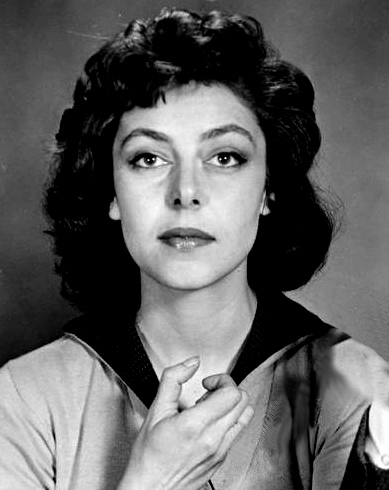
Elaine May, 1959
As I was writing this book, there are three women who I felt I could have written an entire book about; Moms Mabley, Phyllis Diller and Elaine May, and I’m really pleased to know that someone is now at work on an Elaine May biography. She’s a genius. She’s the only woman in the book who’s still alive – she recently turned 90 and this past April received a Lifetime Achievement Award at the Academy Awards. She won a Tony Award on Broadway in 2019, and her acceptance speech is one of the best things I’ve ever seen on an award show. Her career wasn’t what it could have been partly because she was considered “difficult.” A man can be “particular” and a woman doing the same things will be called “difficult,” but I truly believe she was difficult, because her creativity and her energy was so much about the moment that could change as she responded to the mood. You can do that on a comedy stage in a nightclub, or even on a Broadway stage as part of a comedy act, but not necessarily on the set of a feature film.
There’s a story about a gangster movie she directed with Peter Falk and John Cassavetes called Mikey and Nicky, where she had two cameras running, even when the actors were improvising off the set, because she felt there may be something worth filming. That’s great in an improv setting, but when it’s a feature film, keeping the cameras running means you are literally burning money. She never quite developed the tools to succeed in Hollywood, and her film Ishtar became a symbol of Hollywood excess. That movie is much-derided, but if you look at it now, I contend that if it were made by a mainstream Hollywood director, people would not have been so hard on it.
JJM You wrote in the book about how popular Nichols and May were in Greenwich Village nightclubs, including the Village Vanguard, a cathedral of jazz music. What was the importance of venue for women in stand-up comedy?
SL There were certain stages where these comedians seemed to thrive, and others where none of them ever quite had a breakthrough. Phyllis Diller and Joan Rivers felt that they tended to do better in small venues that had a primarily gay clientele, which was unique to women in comedy. This was a time when, in many places around the world, homosexuality was literally a crime, so there was a lot of hiding, and I think the women comedians who slightly distorted their lives and hid behind their humor resonated with those audiences. So they had success in the clubs of Greenwich Village, in San Francisco’s North Beach, and in certain neighborhoods in Chicago, Los Angeles and South Florida, and hit it off better with gay audiences in those clubs than in the “straight” clubs. For instance, the Bon Soir in Greenwich Village was a bar frequented by gay men, and Barbra Streisand – a gay icon – had a breakthrough performance there while working as the opening act for Phyllis Diller. The Blue Angel on the Upper East Side is where Nichols and May and Phyllis Diller had breakthroughs, but they didn’t always jive with the audiences of the bigger “straight” clubs like the Copacabana. The Purple Onion in San Francisco is where Diller got her start, following on the heels of Jorie Remus, who was very popular with gay audiences. And they didn’t do as well in places like Las Vegas, where clubs favored a straight audience. So, early in their careers these women depended on rooms that attracted very hip, select crowds who could read subtext and lived subtext in a way that coincided with the jokes that they were telling – stuff that might have gone straight over the heads of audiences in other venues.
JJM There was a great story in the book that had Belle Barth somehow managing to perform at Carnegie Hall. The audience expected her to do her normal bawdy show, but she didn’t, causing some in the audience to walk out…
SL She had a really tortured career. She was extremely popular on records, but because her reputation was being “filthy,” she couldn’t play the larger venues. People who put her on large stages took the risk of running afoul with the local district attorney. It got to the point where she actually performed at clubs in New York with her lawyer sitting at a front table, and she’d ask the attorney if she could tell a certain joke! Carnegie Hall became a popular comedy venue for a little while – Lenny Bruce, Alan Sherman, Phyllis Diller and even Moms Mabley played there. The first woman to play there, oddly enough, was Minnie Pearl, when in the late 1940’s someone brought country music performers to the Hall, and Minnie did ten minutes on stage before any of the other women comedians got a chance.
.
A video interlude… Joan Rivers and Johnny Carson appear together on the Sammy Davis Show, 1966
.
JJM Of Joan Rivers, you wrote that “all the streams that women comedians had been working in previously came together in one quicksilver package of nerves, angles, jabs and jokes.” What made her successful? How did she become such a giant of comedy?
SL She was a born comedian, and she was in the right place at the right time, and with the right sensibility. She was a doctor’s daughter, born Joan Molinsky in Brooklyn in 1933. She was educated at Connecticut College and Barnard and had all the privileges that came with that. She wanted to be an actress but that never panned out for her. When she went to auditions people would tell her that she was very funny and asked if she had thought about doing comedy. She just wanted to get on the stage, so if they weren’t going to cast her in an acting role, she would get on the stage as a comedian, but, by her own admission, she was terrible at it. Her jokes were bad and not even funny. She tried to be trendy, but she could never quite keep up. But she kept plugging away and spent almost 10 years before her breakout performance on The Tonight Show, and during that time she crafted her persona.
Roy Silver/via Wikimedia Commons
Her agent told her he couldn’t book her as Joan Molinsky so she took the name Joan Rivers, which was her agent’s last name. She said getting into her character was like putting on a cocktail dress. She could be frank about sex and dating, and she had a negative body image both in her real life and in her stage character – she was an attractive young woman but her schtick was that she was undesirable, and that men would flee her or put a bag over her head. She also had the rat-a-tat, one-liner style that Phyllis Diller and a few other women comedians had, but the difference is that she was applying it to jokes about herself. And that seemed very modern.
She’s much more in line with the comedians who came out after 1958 – like Lenny Bruce, Bill Cosby, Godfrey Cambridge, Woody Allen, and Bob Newhart – who performed more topical and psychological humor than the people who came before them. She also had the kind of energy that was jagged and that got on a lot of people’s nerves – she missed a lot of big bookings simply because the people didn’t like her. But that served to feed her comedy. As a young comic, when she needed extra material she hired a writer, Rodney Dangerfield, who himself relied on self-deprecating humor. He was “I can’t get no respect,” and she was “I can’t get a date.” But that also corresponded with this kind of sharpness of her personality. She tried too hard. She wanted to please too much. It was a unique sensibility in comedy.
And as I said, she was just there at the right time. In the mid-1960’s, Phyllis Diller had broken through to become a big star, but her style was in delivering old-fashioned one-liners, bam, bam, bam. Joan Rivers was a little bit more of a storyteller and would tell a series of jokes about her own failings as a woman that people could relate to. She had a big breakthrough with gay audiences in New York who saw themselves as alone in the world and looking for a romantic match. She just hit that note over and over, again and again. And even when her life changed, when she became a star, when she got married, when she became a mother, she could still hold that frame of mind and make jokes about conceiving and giving birth and having a baby and getting married. She could make it sound as if all of these things were trials, not triumphs. She was a unique comic personality and possessed an extremely sharp comic mind.
JJM And she thrived on Johnny Carson and in the world of television…
SL Yes. She broke through in one night on The Tonight Show in February of 1965. She’d been banging on the door for about a decade and she finally cracked it open. I compare that night on Carson to the Beatles in that way, taking all the strains of what had come before them and blowing the world open after performing one night on Ed Sullivan.
JJM Joan Rivers was incredibly active…
SL Yes. She had a syndicated daily afternoon talk show in the 1960’s that went on for hundreds of episodes. It didn’t last, but it succeeded while it was on, eventually airing in almost 50 major markets. She wrote and starred in two Broadway plays – one in the early 1970’s and another in the 2000’s. She wrote a made-for-TV movie called The Girl Most Likely To that was a big hit – a very Joan Rivers-type story about an ugly duckling who gets in a car accident and has plastic surgery and then is a great beauty who takes revenge on all the men who treated her poorly when she was less desirable. In the 1980’s she became the first permanent guest host of The Tonight Show with Johnny Carson, and then went into business against him when the Fox network debuted and set up her own nighttime talk show, which was a first for a woman.
There are two current cable TV series influenced by Joan Rivers’ life; one is the Marvelous Mrs. Maisel, which is like a magical, realist version of her early career, and the other is Hacks, a “what-if” kind of story about a Joan Rivers-type character working in Las Vegas who hires a young, Generation Z writer to be her comedy partner. So hers is a life that spans decades and demonstrates how she is still a relevant figure. When I spoke to younger women comedians for this book – Rita Rudner, Nora Dunn, her daughter Melissa Rivers, and Margaret Cho among them – they all say that Joan was the one who encouraged them, set an example for them, and advised them. She is an amazing figure in this business.
JJM It has been said that we are currently living in a golden age of women’s comedy. Would you agree with that?
SL It’s more golden than it’s ever been, but the only reason I hesitate to call it a “golden age” is because the curve still seems to be going upward, and in 10 years it might be an even more golden age. There are more women than ever performing comedy today on more stages, in more venues, and on more media. They are getting paid better but there are still gaps between men and women comics. Amy Schumer, who on paper is the most successful woman stand-up comedian of all time, has only appeared on the Forbes list of the 10 highest paid comedians three times in her career, twice because she had a hit movie and a hit book at the time. She’s never been more than the middle of the list – she’s always been behind a male ventriloquist who hardly ever plays anywhere except Las Vegas. So the numbers are still prejudicial against women, even though women are rising and rising and rising.
JJM And the women you wrote about helped pave the road for this…
SL Yes, they were the ones who thought there should even be a road, and who went out with their own shovels and pickaxes, creating the path that ultimately became the road.
.
___
.
“By the late 1960’s, when several of these women were fully established in their careers, the idea of a woman standing up and telling jokes no longer seemed freakish or outlandish within show business or among audiences. There was still a lot of work to be done (indeed, even today it needs doing and redoing, in comedy as in so many other fields). They didn’t get the same opportunities as men, or as many of them, or anything like equivalent pay. But the precedent had been set. The women in these pages didn’t really have any antecedents or models they could point back to and say, ‘I’m like her.’ But with their lives and their bodies of work, they established a baseline that later generations of women comedians could use as a starting point for their own fledgling careers. Individually and as a never-really-united group, they created space for a form of expression – women telling jokes – that American popular culture had never truly accommodated until they demanded it be recognized and that continues to grow in size and impact to this day.”
-Shawn Levy, from the introduction to his book In On the Joke: The Original Queens of Stand-up Comedy [Doubleday/a division of Random House]
.
.
___
.
.
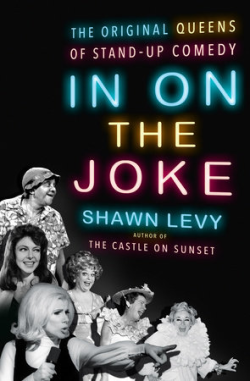
In On the Joke: The Original Queens of Stand-up Comedy [Doubleday/a division of Random House]
by Shawn Levy
.
..
.
Shawn Levy is the former film critic of The Oregonian and KGW-TV (Portland, Oregon). His writing has appeared in Sight and Sound, Film Comment, American Film, The New York Times, the Los Angeles Times, The Guardian, The Hollywood Reporter, and The Black Rock Beacon. He is the bestselling author of Rat Pack Confidential, Paul Newman: A Life, and Dolce Vita Confidential. He jumps and claps, and sings for victory in Portland, Oregon.
www.shawnlevy.com
.
.
Praise for the book:
.
“A sensitive and vivid study of early female stand-ups… [Levy is a] painstaking, knowledgeable guide.”
—New York Times Book Review
.
“Insightful, moving, and well researched, with humorous anecdotes and fond memories of a group of women Levy clearly admires…Levy gives these trailblazers their due, and fans of comedy will adore the snippets of classic banter and long-lost one-liners.”
—Library Journal
.
.“An insightful and impeccably researched examination of the inspirational and fearless female comedians who first trod the unconventional path I gratefully followed. In reading Shawn Levy’s book, I discovered almost every woman changed her original name; in tribute, I’m changing my name to Lady HaHa.”
—Rita Rudner, bestselling author and nine-time recipient of Las Vegas’s “Comedian Of The Year”
.
“A seminal (eew gross I hate that word but it applies here and I love this book) work on the incredible journey of women in comedy, past and present, for all of us hope there will be many more of us in the future.”
—Margaret Cho, Grammy and Emmy Award–nominated stand-up comedian and actress
.
.
___
.
.
This interview took place on May 26, 2022, and was hosted and produced by Jerry Jazz Musician Editor/Publisher Joe Maita
.
Click here to learn how to subscribe to the Jerry Jazz Musician newsletter
.
.
.












